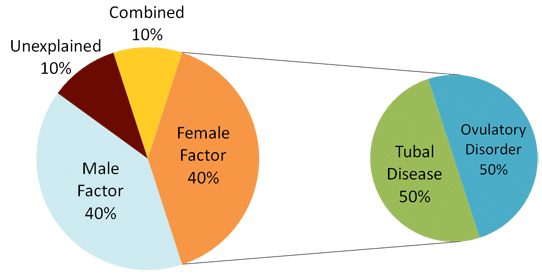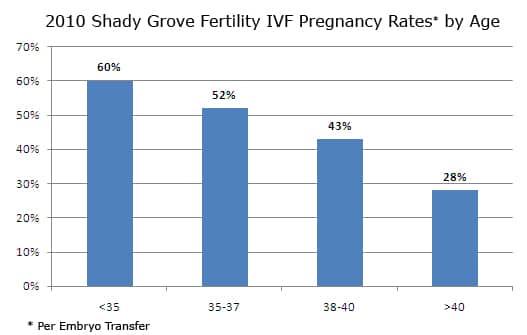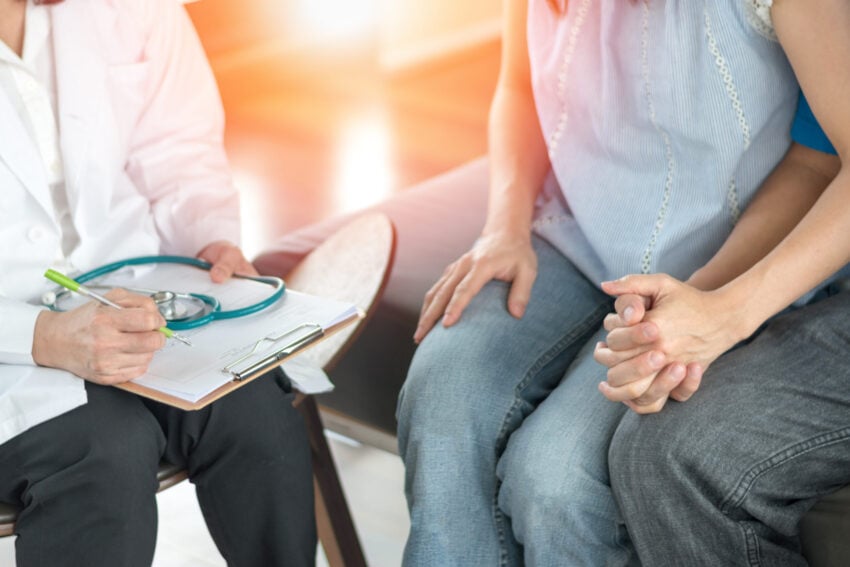While the majority of public perception of infertility is that it’s a disease that affects women who are in their late 30s and 40s, the truth is that infertility is often age-independent. Women of any age can have fertility issues and many times younger women wait much longer to seek treatment than they should.
While age does play a major role in a woman’s ability to successfully conceive a pregnancy due to a reduction in quality and quantity of a woman’s eggs, there are many other factors that play into a woman’s inability to conceive on her own.
How Does Age Play a Role in My Ability to Conceive?
Women are born with about 1 million eggs and as a woman ages, the number of eggs within the ovary begin to rapidly decrease. By the time she starts menstruating, she may only have about 400,000 eggs left.
When a woman reaches her 20s, the chances of becoming pregnant naturally each cycle is only about 20% each month. That number declines gradually through her 20s and early 30s. Once in her mid-to-late 30s and 40s the natural pregnancy rate drops to less than 10%.
Many couples who come to Shady Grove Fertility in their late 30s and into their 40s aren’t naturally getting pregnant largely due to their age. While a woman may be ovulating normally, it may be the quality of those eggs and specifically the genetic abnormalities of the eggs that explain unsuccessful conception.
Fertility treatment success rates follow the same pattern and often, when women are over the age 40, treatment using their own eggs is often unsuccessful and donor egg becomes the only option.
But I’m in my Early 30’s, Why Am I Having Trouble Getting Pregnant?
Younger women who are in their 20s and 30s who are not successfully conceiving may be facing a different set of roadblocks on their way to parenthood. This graphic below outlines the typical causes of infertility:

Two of the most common factors preventing women from conceiving are tubal problems and the inability to ovulate.
Blocked fallopian tubes won’t allow the egg and sperm to meet without intervention, but most women won’t suspect that these blockages are present. They’re virtually indiscernible by the patient but present a true physical barrier to conception.
Some potential causes of blocked fallopian tubes include:
- congenital, structural problems present at birth
- previous surgery in the abdominal or pelvic region
- past non-recognized pelvic infections
If a woman isn’t ovulating, it doesn’t matter how young or healthy she is. To achieve pregnancy, a woman must ovulate. One of the “red flags” for an ovulation disorder might be irregular or absent menstrual periods, at any age. But not all women will experience the tell-tale signs of period problems.
When Should I Consider Seeing a Fertility Specialist?
Shady Grove Fertility recommends that women under the age of 35 schedule a basic fertility diagnostic evaluation with an infertility specialist after one year of unsuccessful conception with unprotected intercourse. Women 35 and older are recommended to seek evaluation after six months of trying, while women who are 40 years or older strongly consider scheduling a consultation as soon as they start planning a pregnancy. The earlier you take that first step to see a specialist, the better chance you have of conceiving a pregnancy.

What Happens Once I Decide To See A Specialist?
Each patient that decides to seek fertility treatment will begin with a basic fertility evaluation that includes the following:
- a blood test for evaluating hormonal function
- a sonogram to get an image of the pelvic organs, looking for any obvious structural problems
- a hysterosalpingogram (HSG) or “tube dye test” to determine if the tubes are clear and the interior of the uterus is normal
- a semen analysis for the male partner
This evaluation is a focused and unintimidating evaluation that can give anyone a feeling of reassurance that their fertility is intact. Or it may be the way that a couple learns not only why they haven’t gotten pregnant, but what treatment is necessary.
Once a diagnosis is determined, Shady Grove Fertility physicians will tailor a treatment protocol specifically for the individual patient. Over 50% of the treatments performed at Shady Grove Fertility are low tech, such as ovulation induction and Intrauterine Insemination (IUI), and, depending on the diagnosis, are most commonly the first methods of treatment attempted.
For example, a 28-year-old patient who has been diagnosed with an ovulatory disorder such as PCOS may begin her treatment with a couple cycles of oral medication (such as clomiphene citrate). This may be combined with either timed intercourse or IUI. This provides the patient and the physician with a good starting point in determining what the most successful method of treatment is for that individual.
If it’s determined that the patient ovulates multiple eggs per cycle on the stimulation medication then she may be transitioned to IVF so our physicians can control the odds of multiples by the transfer of a single, high-quality embryo. An additional benefit to using IVF is that extra embryos can be frozen and then used by a couple as many as years down the road to add children to their family — without an additional cycle of IVF.
So What’s the Bottom Line?
There are many options from low tech to high tech treatments with promising success rates for all diagnosis, but they are again age-dependant. The earlier you get started, the greater your chances of success. Men and women of all ages can increase their chances for successfully having children by having greater understanding of their fertility factors and, most importantly, by not letting the fear of seeking the help from a fertility specialist stand in the way.
Whatever your questions are, we are here to help you. Don’t hesitate to call 888-761-1967 to speak with one of our friendly New Patient Liaisons who can help answer your questions as well as schedule a new patient appointment with one of our physicians.





